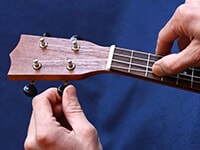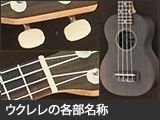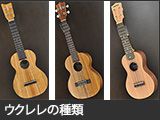Hello, this is Conservario.
Whether you play the ukulele, guitar, piano, or any other instrument, have you ever thought about what it really means to ‘play a sound’?
Taking a moment to reflect on this can significantly improve your performance.
This knowledge applies beyond the ukulele, so I encourage you to read on!

Let’s start with the conclusion.
Playing a sound involves three essential actions: producing the sound, sustaining it, and stopping it. You might think, “Well, that’s obvious—I already know that!” But let me ask you:
Before you play a note, have you ever consciously thought about what kind of sound you want to produce? When sustaining a note, do you consider how many beats to hold it for or whether to add vibrato?
When stopping a note, do you think about whether to cut it off sharply or let it fade naturally?
Most players don’t give much thought to these aspects.
Many simply strum familiar chord shapes or follow tab numbers without considering these details.
That’s perfectly fine if your goal is to casually enjoy playing.
However, if you aim to level up your skills or pursue music professionally, this mindset won’t cut it. Let’s break it down step by step.
■ Producing Sound
Think about the kind of sound you want to create.
Do you want it to be soft? Loud? Hard? Gentle? Fast or slow strumming? Bright or dark?
Reflect on how you usually play.
Do you only focus on whether the correct note comes out and stop there?
When producing sound, it’s essential to consider how your right hand plays.
Will you use your thumb or index finger? Will you use large or small movements? Even small changes can affect the sound significantly.
Try to think: “This chord in this part of the song should sound like this!” before you start playing. It can be overwhelming to focus on every note at first, so start by being mindful of your favorite parts or the most important sections.
Just doing this will improve the quality of your performance.
■ Sustaining Sound
Think about how you want to sustain the sound.
Will you use vibrato or not? How many beats will you hold the note? In solo ukulele playing, how will you sustain the high and low notes differently?
An important point to understand is that the ukulele is classified as a plucked string instrument.
Any instrument that produces sound by plucking strings falls into this category
The guitar, mandolin, and shamisen are plucked string instruments.
On the other hand, instruments like the violin are classified as bowed string instruments.
These instruments produce sound by bowing the strings
The viola and cello are bowed string instruments.
While both are string instruments, the way they produce and sustain sound is very different.
Bowed instruments can gradually increase their volume from zero and even control the dynamics while sustaining a note.
However, plucked instruments like the ukulele and guitar have their loudest moment at the initial attack, and the sound naturally fades from there.
This is simply the nature of these instruments.
That said, this doesn’t mean you should neglect how you produce and sustain notes.
Unlike the piano, the ukulele allows for vibrato.
Use this advantage to carefully consider how you sustain your notes while playing.
■ Stopping the Sound
This is the final step.
Stopping a sound is one of the most important aspects of ukulele playing, yet it’s often the most overlooked.
In fact, the reason I decided to write this column was to emphasize just how crucial stopping a sound is.
Most players don’t pay much attention to how they stop their notes.
They either do it carelessly or haven’t even thought about it at all.
If a note rings out clearly, they consider it “good enough,” but this kind of mindset leads to sloppy endings.
With wind instruments like the flute or saxophone, you must think about how to end a note—otherwise, you can’t even play properly.
As humans, we can’t sustain a breath forever, so players must carefully control their breathing and phrasing.
In contrast, with plucked instruments like the ukulele or guitar, once a note is played, it naturally sustains on its own.
Because of this, most players focus on whether a note sounds clear and correct, but they often neglect how to end it.
So, how should you stop a sound?
How many beats should you let it ring before stopping?
Will you stop it abruptly or let it fade out gradually?
Only when you properly stop a sound can you truly complete the act of “playing a note.”
■ Conclusion
Producing a sound, sustaining it, and stopping it.
—These three elements are all equally important.
If any one of them is neglected or handled carelessly, a performance will never truly be great.
In particular, many players tend to be careless when it comes to stopping notes, simply because of the nature of the instrument.
However, no professional or skilled musician takes any of these three steps lightly.
It’s precisely this attention to detail that separates professionals from amateurs.
If you’re just playing for fun, this level of precision might seem unnecessary—but even making a small effort to be more mindful of these aspects will elevate your performance.
Your playing will undoubtedly improve.
Thank you for reading!
The “sound & person” column is made up of contributions from you.
For details about contributing, click here.











![[Enjoy the Ukulele Even More!] Hacks to Keep Your Strings Going Longer](/contents/uploads/thumbs/5/2022/3/20220317_5_17094_1.jpg)
![[Enjoy the Ukulele Even More!] Commonalities Between the Ukulele and the Guitar](/contents/uploads/thumbs/5/2022/3/20220317_5_17091_1.jpg)
![[Enjoy the Ukulele Even More!] For Those Who Feel Their Strumming Has Become Repetitive](/contents/uploads/thumbs/5/2022/2/20220228_5_16890_1.jpg)
![[Enjoy the Ukulele Even More!] Do I Have to Practice the Basics?](/contents/uploads/thumbs/5/2022/2/20220221_5_16789_1.jpg)
![[Enjoy the Ukulele Even More!] Ukulele Condition Check You Should Do](/contents/uploads/thumbs/5/2022/2/20220214_5_16699_1.jpg)
![[Enjoy the Ukulele Even More!] Basic Knowledge Before You Start Playing](/contents/uploads/thumbs/5/2022/2/20220214_5_16700_1.jpg)
 ウクレレのチューニング方法
ウクレレのチューニング方法
 ウクレレの各部名称
ウクレレの各部名称
 ウクレレの種類
ウクレレの種類
 ウクレレスタートガイド
ウクレレスタートガイド
 めちゃラク!ギター講座
めちゃラク!ギター講座
 ウクレレ初心者講座
ウクレレ初心者講座















